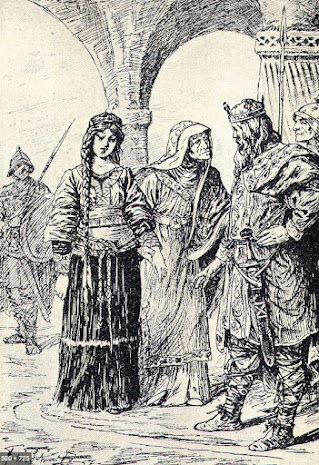Desideratum (pronounced dih-sid-uh-rey-tuhm, dih-sid-uh-rah-tuhm or dih-zid-uh-rey-tuhm)
Something
wanted or needed; something lacked and desired.
1645-1655:
A learned borrowing from Latin dēsīderātum
(something that is desired), neuter nominative singular of dēsīderātus, the passive past participle of dēsīderāre (to desire), from dēsīderō
(to desire, want, wish for). The
construct in Latin has long been debated with most etymologists preferring the
prefix de- (the Latin intensifer) + (possibly) sīdus (star; constellation) though the connection is speculative. The English word is cognate with the French desideratum and the Spanish desiderátum. The noun plural was dēsīderāta, rendered in English as desiderata.
An
example of a Latin word in English (while remaining still obviously “foreign”, other
offshoots of the Latin verb were nativized in Middle English: desiderable (wished for, desired (mid-fourteenth
century) also worthy of being admired); desideracioun
(longing, yearning (late fifteenth century)); desiderantly (with ardent desire (circa 1500)). The related form desiderate (feel a desire or longing for) dates from the 1640s but
is long extinct.
Charlemagne and Desiderata
Desiderata (written sometimes as Ermengarda) was one of four daughters of Desiderius, King of the Lombards. In the year 770, in an arranged political marriage, fashionable at the time, she became Charlemagne’s (748-814) second wife, an attempt to make less unfriendly the relations between the Franks and the Lombards. The union was controversial. Pope Stephen III approved not at all of the Lombards, regarding them as barbarians and Charlemagne seems not to have been enthusiastic, the marriage producing no issue and lasting barely a year with all records of it erased from the Royal Frankish Annals. One biographer noted the ceremony but claimed it was all the idea of Charlemagne’s mother.
Debate still surrounds her name. Some historians suggest Desiderata emerged from a nineteenth century editorial error during the transcription of the Monumenta Germaniae Historica which capitalized the 'D' in desideratam filiam (“desired daughter” in Latin) and it’s more likely Desiderata's name was actually “Gerperga”. The evidence offered for the hypothesis is somewhat circumstantial but the name certainly fits in with the names of Desiderius' other daughters, all of which end in the suffix “perga”. Even this error was sometimes compounded by a back formation to Desideria, a more probable first name (the feminine form of Desiderius, her father's name), or translated (as into French) as Désirée.
Charlemagne and Desiderata. In art, Desiderata is depicted usually as the same height as her husband or only slightly shorter and paintings of her alone show a willowy figure.
In Medieval legend, Charlemagne was often said to be 6’ 6” (2m) in height and that, tall even today, would have meant he towered over his subjects, a typical male in the Carolingian period standing about 5′ 6″ (1.69m). Up to a point, height confers many advantages and is historically associated with authority and leadership so a little Medieval exaggeration is not unexpected, research now suggesting Charlemagne, although tall, wasn’t quite as elongated as his myth. Using x-rays and CT Scans to examine his bones lying in the Aachen Cathedral, scientists concluded he was between 5′ 10″ and 6′ 4″ (1.79-1.92). This finding is supported by some contemporary evidence, his friend and courtier, the Frankish scholar Einhard (E(g)inhardus in the Latin and known also as Eginhard or Einhart, circa 775–840) noting he “…was large and strong, and of lofty stature, though not disproportionately tall”.
The statuesque Desiderata at home.Whether there’s artistic licence in the art in which Desiderata appears isn’t known but for her to be close to Charlemagne’s height would have made her very tall for the time. That is of course not impossible. Human height is determined by genetics and while factors like health-care and nutrition can, over generations, have the effect of increasing the average height of given populations, it’s possible the absolute maximum height attainable has changed not at all during the existence of modern humans. That may apply also to age; although the average of the life-span may increase, the maximum possible under ideal genetic and environmental circumstance may be the same now as thousands of years ago. Whether the increasing understanding of DNA and genetic manipulation will allow us to tamper.


No comments:
Post a Comment